On May 24, 1802, the fossors who worked to free Priscilla’s catacombs from materials and rubble built up over the centuries had reached its centre, not far from the Greek Chapel, very close to the skylight (fig.5). One of them, who remains unknown, when removing the soil from one of the tunnels, hit some tiles which had kept a niche closed.
|
Excerpts from the Official Website of the Shrine of St. Philomena http://philomena.it
On May 24, 1802, the fossors who worked to free Priscilla’s catacombs from materials and rubble built up over the centuries had reached its centre, not far from the Greek Chapel, very close to the skylight (fig.5). One of them, who remains unknown, when removing the soil from one of the tunnels, hit some tiles which had kept a niche closed.
7 Comments
VATICAN CITY - 26 April 2016, Pope Francis received Cardinal Angelo Amato, sdb, Prefect of the Congregation for the Causes of Saints in a private audience. In the course of the audience, the Holy Father authorized the Congregation to promulgate decrees regarding:
VATICAN CITY - At 10:00 a.m., in the Concistory Hall of the Vatican Apostolic Palace, Pope Francis held an ordinary public consistory during the celebration of midmorning prayers for the canonization of Blesseds:
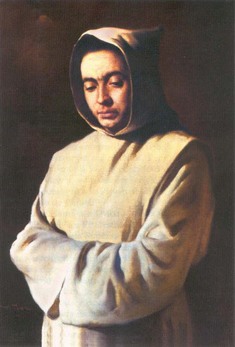 Brother Rafael was not and could not be other than young. His life of only 27 years was framed between a Palm Sunday and an Easter Sunday. His life is condensed principally in his youth, because it is in youth that the most promising hopes are sown and germinated. What is seed and germ today will be flower and fruit tomorrow. With a brilliant intelligence, distinguished manners, a jovial character, frank and happy, but still, with all this, extremely simple, Rafael, as he grew in age and in development of his personality grew also in spiritual experience and in the Christian life, toward which he felt drawn from his earliest childhood, giving clear signs of an attraction toward the things of God. The Lord roused within Rafael's well-disposed heart the invitation to give himself completely to God by means of a special consecration in the monastic life. It happened that one day Christ crossed his path, and Rafael, following Him very closely, tried to overtake Him, leaving behind his promising career as architect, with all its dreams and prospects, and entering not only once but twice, three, and four times the Cistercian Monastery of San Isidro de Duenas, first as a Novice, then as an Oblate, so that he might be, within the simplicity of the hidden life, a heroic witness of the Passion of Jesus Christ. In his incurable illness of diabetes, he embraced the Cross with an almost savage love and came to desire the will of God with such a deep-seated determination that he made of it his only norm and rule: "I want nothing other than God, and His Will shall be my will . . ." "Happy the man who sees nothing more than the will of God...." "My only desire is to unity myself absolutely and entirely with the will of Jesus...." "I want to die loving the will of God." The perfume of his life and his numerious writing continues to spread in all directions and to be well received for the good of all those who, through them, enter into contact with his spirituality. It is a spirituality rich in nuances, but it can be condensed within a phrase, which for him covered everything: "God alone!" Fascinated by God, he consumed his life in love. A very significant trait of his spirituality was his heart-felt love for Mary. She was his help and his light, and in her he took shelter with tenderness, confidence, and simplicity. Taken from http://www.trappists.org/ 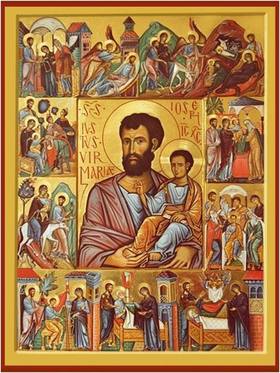 St. Joseph, in all likelihood, was born in Bethlehem, and it is generally assumed that he died at Nazareth before Jesus began his ministry. The Bible tells us very little of Joseph, but from the early chapters of Matthew and Luke we glean that he was a carpenter by trade, a just and pious man, and a most excellent husband and father. The genealogy given in Matthew i, 1-17, traces his line from Abraham and King David. In accordance with the Jewish ritual, he was betrothed to the Virgin Mary, who was also of the race of David. Later, having learned that she was with child, though he had not been near her, he was privately considering putting her away. Yet he hesitated, for he was a kindly man, and he did not wish to expose the young woman to the reproach which such an action would bring. It was at this time of uncertainty that the angel of the Lord appeared to Joseph in a dream and revealed to him the Mystery of the Incarnation. "Do not be afraid, Joseph, son of David," said the angel, "to take to thee Mary thy wife, for that which is begotten of her is of the Holy Spirit. And she shall bring forth a son, and thou shall call his name Jesus; for he shall save the people from their sins" (Luke i, 20-21). Joseph now accepted without question the two-fold office with which he was charged, protector of Mary's honor and foster father of the child that was to be born. He took Mary with him from Nazareth to Bethlehem, when, in compliance with the Roman edict, it was necessary to return there for the census-taking. Then came the birth of the Lord. We know that Joseph was at the stable of the inn beside his wife when the three wise men, following a star, came there out of the East to honor the newborn child with precious gifts. The infant was duly circumcized, and when the forty days prescribed by Mosaic law were passed, Joseph and Mary took him to the temple in Jerusalem. A certain holy man named Simeon, to whom it had been revealed that he would not die until he had seen the Christ, was in the temple on that day, and when he saw Jesus, he knew that this was the promised Messiah. The priest blessed Joseph and Mary and spoke of the glory that had come to them. The angel of the Lord again appeared to Joseph to tell him to flee with his family into Egypt to escape the wrath of the jealous King Herod. Obediently Joseph hastened to comply, and the family stayed in Egypt until word came of Herod's death, when it was safe for them to return to their homeland. Back in the pleasant hill-town of Nazareth, Joseph carried on his trade, teaching it to Jesus as the boy grew older. The important event of every year was the Passover, when the pious traveled to Jerusalem to share in the ceremonies. Joseph and Mary were in the habit of going on this journey, and we are told that Joseph shared his wife's anxiety when, on one such occasion, the twelve-year-old Jesus became separated from them, and was later found debating with the learned men in the temple. Thus all we know of Joseph adds to the picture of the gentle, protective father and husband. Veneration of this saint played no part in primitive Christianity. Recognition seems to have developed first among the Copts, a branch of Eastern Christendom. Devotion to St. Joseph was practiced from very early times in Ireland, and in the Middle Ages in Europe many fanciful stories were woven about his name. In spite of this popularity, it was not until 1870, under Pope Pius IX, that he was proclaimed patron of the Universal Church, and Wednesdays in March were set for special devotion to him. The great number of churches dedicated to St. Joseph is an indication of the breadth and depth of this veneration. St. Joseph is patron of carpenters and of a happy death; his symbols are the rod and the plane. Saint Joseph, Foster Father of the Lord. Scriptural Saint. Celebration of Feast Day is March 19. Taken from "Lives of Saints", Published by John J. Crawley & Co., Inc. 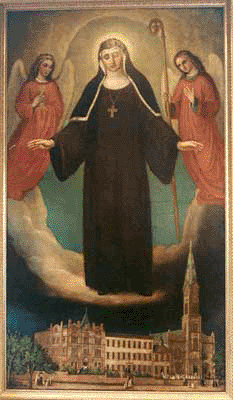 St. Walburga was born around 710. She is the daughter of St. Richard and the niece of St. Boniface. When St. Richard set out for a pilgrimage to the Holy Land with his sons, Ss. Willibald & Winibald, he entrusted 11 year old Walburga to the monastery school at Wimborne. She remained as a nun, spending a total of 26 years there. When St. Boniface put out an appeal for nuns to help him in the evangelization of Germany, St. Walburga answered the call. On the way to Germany, there was a terrible storm at sea. Walburga knelt on the deck of the ship and prayed. The sea immediately became calm. Some sailors witnessed this and spread the word that she was a wonderworker, so she was received in Germany with great respect. At first, she lived at Bischofsheim, under the rule of St. Lioba. Then she was made abbess at Heidenheim, near to where her brother, Winibald served as an abbot over a men's monastery. After his death, she ruled both monasteries. She worked many miracles in the course of her ministry. She wrote a biography of her brother, Winibald, and of Willibald's travels in Palestine, in Latin. She is regarded as the first woman author in both England and Germany. On September 23, 776, she assisted Willibald in translating the uncorrupt relics of their brother, Winibald, to a new tomb in the church at Heidenheim. Shortly after this, she fell ill. Willibald cared for her until she died on February 25, 777, then placed her next to Winibald in the tomb. After St. Willibald's death in 786, people gradually forgot St. Walburga and the church fell into disrepair. In 870, Bishop Oktar was having Heidenheim restored. Some workmen desecrated Walburga's grave. She appeared in a dream to the bishop, who then translated her relics to Eichstadt. In 893, St. Walburga's body was found to be immersed in a mysterious sweet-smelling liquid. It was found to work miraculous healings. The liquid, called St. Walburga's oil, has flowed from her body, ever since, except for a brief period when the church was put under the interdict after robbers shed the blood of a bell-ringer in the church. Portions of St. Walburga's relics have taken to several other cities and her oil to all parts of the world. Taken from CatholicCulture.Org On August 27, 1832 Fr. Charles-Eléonore des Genettes took over, as pastor of the poor abandoned church “des Petits-Pěres” which had served as the Stock Market exchange during the revolution of 1830. On the Sunday following his installation, He could only count four persons at the high mass, in addition to the clergy and choir and that during the entire year of 1835, only 720 communions were distributed.
By the late Rev. McGowan
What's wrong with meekness? Is the meek man a Milquetoast who is too spineless and weak-kneed to face up to the battle of life?This is the false face of meekness spread by our TV and modern novels. By the late Father Kilian McGowan, C.P.
More books, pamphlets and columns on peace of soul have probably been written in the last decade than in all the time since the birth of Christ. No generation has sought peace more desperately than our own. Yet, this desirable state of mind and heart seems to be more elusive than ever. 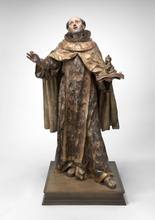 Born in poverty. Cared for the poor in the hospital in Medina del Campo, Spain. Carmelite lay brother in 1563 at age 21, though he lived more strictly than the Rule required. Studied at Salamanca, Spain. Carmelite priest, ordained in 1567 at age 25. Persuaded by Saint Teresa of Avila to begin the Discalced or barefoot reform within the Carmelite Order, he took the name John of the Cross. Master of novices. Spiritual director and confessor at Saint Teresa‘s convent. His reforms did not set well with some of his brothers, and he was ordered to return to Medina del Campo. He refused, and was imprisoned at Toledo, Spain, escaping after nine months. Vicar-general of Andalusia, Spain. His reforms revitalized the Order. Great contemplative and spiritual writer. Proclaimed a Doctor of the Church by Pope Pius XI on 24 August 1926. |
Archives
May 2016
Categories
All
|

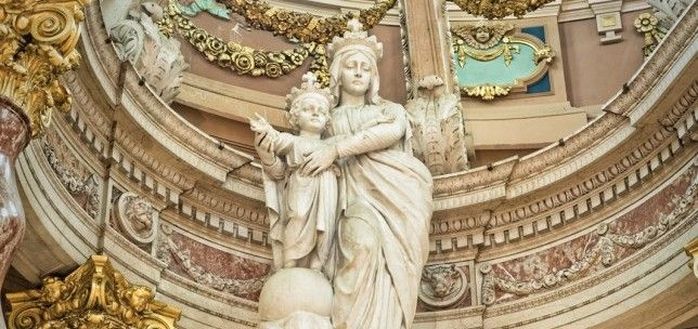

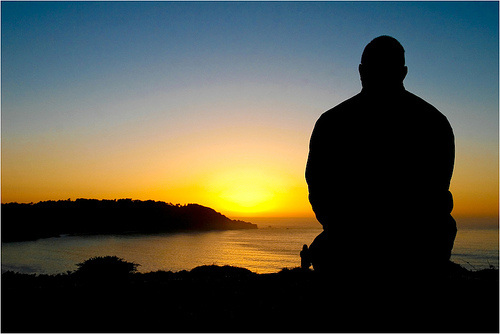
 RSS Feed
RSS Feed
